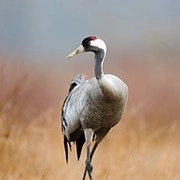Gateway to the Himalayas

Dear Lykkers! Certainly, the Dzongri trek is undoubtedly one of the essential paths for experiencing the essence of the Eastern Himalayas. Dzongri Top provides an otherworldly 360-degree panorama of the whole Sikkim and Darjeeling Himalayas.
From the Far East, the snow-covered giants rise majestically, spanning the entire North and extending to Bhutan, reaching the western horizons. Rathong, Kokthang, South & Dome, Kanchendzongha, Pandim, Narsing, Tinchenkhang, and Simvo are a few of the significant ones.
During your journey, you pass through Temperate Broad-Leaved Forest and mixed Coniferous/Sub-Alpine Forest and arrive at the edge of areas solely covered by Alpine Scrub and Grass. This varied biosphere classified as Group 12 Himalayan Moist Temperate Forest is extremely abundant in a wide array of plant and animal life. The period from April to May is ideal for visiting this sanctuary to view numerous rhododendron species glowing vividly in all the corners.
Chasing Waterfalls? Cherrapunji is Your Ultimate Destination!
10 Dreamy Getaways Near Mumbai You Can’t Miss!
Conquer 9999 Steps to Discover Gujarat’s Hidden Gem: Mount Girnar!
Explore Hanoi, Vietnam: The Ultimate 3-Day Itinerary.
Why Is Tehri Lake the Perfect Destination for Adventure and Healing? It Offers Both Thrills and Tranquility!
Why Is Edward Elliot's Beach So Loved? Pristine Sands and Tranquil Vibes Hold the Secret!
Concise Schedule for Dzongri Trek:
Day 1: NJP/Bagdogra to Yuksom – 160 Km by vehicle – 8 hours. Staying at a homestay or lodge.
Day 2: Hike to Sachen – 8 Km – 4 hours. Campsite.
Day 3: Hike to Tsokha – 7 Km – 4 to 5 hours.
Day 4: Hike to Phedang – 6 Km – 3 to 4 hours.
Day 5: Journey to Dzongri through Deorali Top – 6 Km – 3/4 hours.
Day 6: Discover the surroundings of Dzongri. Ascend to the summit of Dzongri for the sunrise. After having breakfast, go to Laxmi Pokhri and return for lunch.
Day 7: Hike back to Tsokha – 12 Km – 5 to 6 hours. Camp.
Day 8: Hike back to Yuksom – 15 Km – 5 to 6 hours. Lodging or homestay options.
Day 9: Yuksom to NJP/Bagdogra – 160 kilometers by vehicle – 8 to 9 hours.
Trekkers must arrive no later than 10 am on Day 1 at NJP/Bagdogra. On Day 10, you will head back to NJP/Bagdogra with an 8-hour drive from Yuksom, approximately arriving around 4-5 pm.
Why Visit Dzongri Campsite?
Panoramic Views: Dzongri is celebrated for its sweeping views of majestic peaks like Kanchenjunga, Pandim, and Kabru, especially during sunrise.
Tranquil Environment: Surrounded by lush rhododendron forests and alpine meadows, it offers a serene escape from the chaos of daily life.
Trekkers’ Delight: It serves as a vital stop on the popular Dzongri-Goechala trek, drawing adventurers from around the globe.
Activities at Dzongri Campsite
Treks and Hikes: Explore nearby trails leading to Dzongri La Pass or head to viewpoints for spectacular vistas.
Camping: Spend the night under a star-studded sky amidst the serene wilderness.
Avian species and fauna along the Dzongri trek:
Birdwatchers who visit will find this location very attractive, as this National Park is part of the Important Bird Area (IBA) network, housing approximately 550 species and subspecies of birds. Some species of this kind encompass vibrant high-altitude pheasants such as Tragopan pheasants and Blood pheasants, Tibetan Horned owls, Hill Partridge, Forest Eagle, Falcons, Hawks, and even some Lammergeiers. This National Park is inhabited by a diverse array of wildlife, such as the Red Panda, Snow Leopard, Common Leopard, Himalayan Black Bear, Lesser Cats, Mountain Fox, Kasturi Mriga/Musk Deer, Nayan/Great Tibetan Sheep, Bharal/Blue Sheep, Shapi/Himalayan Tahr, Barking Deer, Martens, and Pikas, among others.

Accommodation Options
Tents at Dzongri: Most trekkers stay in tents, which offer a close-to-nature experience. Costs for guided trekking packages, including food and camping, range from $100 to $200.
Homestays in Yuksom: Before and after the trek, enjoy cozy stays in Yuksom for $20 to $50 per night.
Dzongri trek climate:
The Sikkim Darjeeling area and its surroundings are recognized for their humid climate, nearly throughout the year. At elevated altitudes, moisture compounds the inherent cold temperatures.
Typically, the lowest temperature in a location occurs in the early morning hours, between 3 and 5 am. While trekking to Dzongri, there are a few days (one at Phedang and another at Dzongri) when you need to depart from camp early in the morning. In the height of winter, from late December, temperatures at Dzongri may drop to as low as -10°C. Consider that strong winds can occasionally make you feel colder. The wind chill factor can make the temperature feel colder than it is. The temperature inside the tent will be approximately 10°C higher than the outside temperature. In daylight, temperatures will be lower and may range from 10°C to 25°C based on the season and elevation.
Dzongri Campsite is more than just a trekking stop; it’s a sanctuary of natural beauty and tranquility in the Himalayas. Whether you’re a seasoned adventurer or a nature enthusiast seeking peace, Dzongri offers an unforgettable escape. Gear up and let the Himalayas captivate your soul!
VLOG 3: TSHOKA - DZONGRI - CHAURIKHANG (BASE CAMP 14600FEET)
Video by Sai Mukunda

 · Travel team
· Travel team